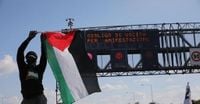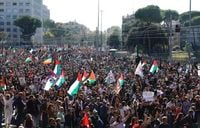On October 3, 2025, Italy witnessed one of its most widespread and impassioned general strikes in recent memory, as tens of thousands—by some counts, millions—filled city squares, blocked roads, and brought parts of the nation’s infrastructure to a standstill. The strike, called by the CGIL (Italian General Confederation of Labour) and grassroots unions, was staged in solidarity with the Global Sumud Flotilla and the people of Gaza, drawing both praise and condemnation from across the political spectrum and sparking heated debate over its legality, meaning, and impact.
The mobilization swept across more than 100 cities, with CGIL claiming over 2 million participants in 100 squares nationwide, while Italy’s Interior Ministry, the Viminale, reported a more conservative figure of around 400,000 across 29 major events. The discrepancy in numbers became just one of many points of contention as the day unfolded.
Rome’s streets were awash with union and Palestinian flags as crowds marched from Piazza Vittorio toward the main train station, chanting slogans condemning Israeli actions against the flotilla bound for Gaza. Organizers estimated 300,000 participants in the capital alone, while local police (the Questura) put the number at a more modest 80,000. In Milan, at least 100,000 people, according to organizers, took to the streets, with the city’s iconic Duomo square a focal point for demonstrators. Naples, Venice, and cities in Sicily, Puglia, Emilia-Romagna, and beyond saw similar scenes, with numbers ranging from several thousand to over 200,000 in Emilia-Romagna, according to CGIL regional secretary Massimo Bussandri.
The strike was not without its disruptions. Italy’s rail network suffered widespread delays and cancellations, with stations in Florence, Genoa, Trento, and Milan affected by protesters occupying tracks. In Rome, trains at Termini station were canceled or delayed by up to 80 minutes. Milan’s metro lines M1 and M3 closed after 6 p.m. due to the demonstrations, while other lines operated with significant diversions. Airports, including Pisa’s Galileo Galilei, faced temporary suspensions as protesters invaded runways. Motorways and ring roads around major cities such as Rome, Milan, Bologna, and Trento were blocked, causing gridlock and frustration among motorists and truck drivers.
Some protests remained peaceful, marked by chants of “Free Palestine” and calls for an immediate ceasefire in Gaza. In Pescara, thousands of students and workers paralyzed city traffic, while in Ancona, 10,000 demonstrators blocked the port, waving banners and chanting, “Free Palestine from the river to the sea.” The atmosphere in these marches was charged but largely orderly, with many local authorities and mayors, including those from Abruzzo and Sardinia, expressing solidarity with the Palestinian people. In Messina, demonstrators hung a Palestinian flag from City Hall, prompting the mayor to address the crowd directly, asking for continued peaceful protest.
Other cities, however, saw clashes between protesters and police. In Milan, Bologna, Turin, and Padua, police responded to stone- and bottle-throwing demonstrators with tear gas and water cannons. In Turin, a group of antagonists attempted to storm the Leonardo headquarters, damaging cars and property. Police reported 55 injuries among officers over two days, underscoring the volatility of some confrontations. In Trento, protesters who occupied railway tracks were identified and referred to judicial authorities, while in Ferrara and Genoa, attempts to occupy stations were met with heavy police presence.
The strike’s political undertones quickly surfaced. Interior Minister Matteo Salvini condemned the action as “political warfare” from CGIL, arguing, “We gave them a chance, they preferred to make political war, talking about peace, we will know how to behave.” He further criticized the strike’s legality, noting that it was declared with insufficient notice and threatening heavy penalties for organizers. Salvini’s stance was echoed by Minister for Public Administration Paolo Zangrillo, who pointed to a relatively low 7% participation rate among public sector workers and insisted that essential services were maintained. “The public administration has guaranteed full operations, thus ensuring the provision of services to citizens without inconvenience,” Zangrillo stated.
CGIL leader Maurizio Landini, meanwhile, fiercely rejected accusations of political warfare. “There is no political war. Salvini is two days that as a minister he is threatening citizens who freely use a right enshrined in the Constitution,” Landini told Rai3. He argued that the strike was not just a labor action but a stand “to defend brotherhood among peoples, to put humanity back at the centre, to say no to genocide, to a policy of rearmament.” Landini’s call for solidarity was echoed by local union leaders, who described the mobilization as a humanitarian reaction and “something to be proud of.”
Other voices joined the debate. Interior Minister Matteo Piantedosi described the strike as a “call for social revolt,” suggesting that the issues raised were less about employment and more about broader political grievances. Elly Schlein, secretary of the Democratic Party, defended the right to strike, asserting, “Hands off the right to strike. We are with the workers.” On the other side, the Israeli ambassador in Rome, Jonathan Peled, dismissed the protests as “anti-government marches” with “nothing to do with Gaza and the Palestinians,” accusing some demonstrators of ignorance and radicalism.
Across the country, the strike’s impact varied. In Basilicata, peaceful parades in Potenza and Matera drew about 2,000 participants each, while in Molise, a thousand people marched in support of Gaza. In Puglia, 20,000 filled the squares, with strike adherence rates exceeding 50% in some sectors. In Florence, union officials noted that participation rivaled the historic Social Forum of 2002, and in Bergamo, the city displayed peace, Ukrainian, and Palestinian flags from its municipal building as a gesture of solidarity.
The strike also ignited debate over its effectiveness and broader significance. Some critics, including the Fai Cisl agricultural union in Basilicata, dismissed the protest as “political and ideological,” arguing it would not advance peace in the Middle East or alleviate Palestinian suffering. Yet, for many participants, the strike was a vital expression of international solidarity and a demand for political action—both at home and abroad.
As the day ended, the queues of marchers and traffic jams slowly dissipated, but the questions raised—about solidarity, the limits of protest, and Italy’s role in international affairs—remained very much alive. The strike’s scale and passion ensured it would not be quickly forgotten, and with further demonstrations already planned, Italy’s streets seem likely to remain a stage for debate and dissent in the weeks ahead.



